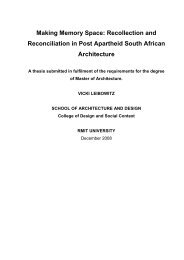Objects in Flux - RMIT Research Repository - RMIT University
Objects in Flux - RMIT Research Repository - RMIT University
Objects in Flux - RMIT Research Repository - RMIT University
You also want an ePaper? Increase the reach of your titles
YUMPU automatically turns print PDFs into web optimized ePapers that Google loves.
<strong>Objects</strong> <strong>in</strong> <strong>Flux</strong><br />
[Figure 6-11]<br />
Street advertisement for iSOP,<br />
Melbourne, Australia, 2006.<br />
Image is author’s own.<br />
17/ As Steven Weber states <strong>in</strong> The<br />
Success of Open Source, unlike pro-<br />
prietary software, ‘property <strong>in</strong> open<br />
source is configured fundamentally<br />
around the right to distribute, not the<br />
right to exclude’ (2004). Free and<br />
Open Source Software (FOSS) does<br />
not oppose copyright law, but rather<br />
reth<strong>in</strong>ks it from with<strong>in</strong>, deploy<strong>in</strong>g<br />
the copyright mechanism but not the<br />
overarch<strong>in</strong>g logic. Strictly speak<strong>in</strong>g,<br />
the FSF’s ability to claim a space and<br />
dictate the rules of that space means<br />
that its actions cannot be thought of<br />
as tactical <strong>in</strong> de Certeau’s sense of the<br />
term. However, open<strong>in</strong>g up this space<br />
<strong>in</strong>volved a tactical engagement with<br />
the dom<strong>in</strong>ant logic of copyright law<br />
and the re-figur<strong>in</strong>g of this law <strong>in</strong>to an<br />
alternative doma<strong>in</strong>.<br />
120<br />
the Free Software Foundation (FSF) reth<strong>in</strong>ks copyright<br />
law not as a system for secur<strong>in</strong>g property rights but as a<br />
mechanism by which property rights may be figured as<br />
communal and social. 17<br />
Through these acts, hackers and modders make the<br />
dom<strong>in</strong>ant logic ‘function <strong>in</strong> another register’ (de Certeau,<br />
1984, p. xxi). And, as Colebrook states, ‘the very<br />
system of our logic, the exhaustive map of the real, is<br />
‘opened’ to a vacillation, doubl<strong>in</strong>g, or hesitancy’ (2001,<br />
p. 558). While these acts of resistance are often transitory,<br />
they are not without effect. In their ‘perversion’ of<br />
the dom<strong>in</strong>ant logic, tactics expose the forces through<br />
which this logic is established and ma<strong>in</strong>ta<strong>in</strong>ed. Colebrook<br />
expla<strong>in</strong>s the situation as follows:<br />
‘Strategy is a logic or calculus of the proper. Each po<strong>in</strong>t <strong>in</strong> the whole<br />
has its proper term and name without difference, movement or ambiguity.<br />
Indeed strategy occurs only when the event of nam<strong>in</strong>g and<br />
order<strong>in</strong>g this space as a place is forgotten. This is where tactic and<br />
memory as metaphysical <strong>in</strong>tervene. Here a doubl<strong>in</strong>g occurs that does<br />
not take us to another place, but repeats the place already given and <strong>in</strong><br />
so do<strong>in</strong>g reveals the way <strong>in</strong> which place is generated from space, the<br />
way <strong>in</strong> which the literal is given through figure’ (2001).<br />
In the dist<strong>in</strong>ction made here between ‘space’ and ‘place’ we see the<br />
normaliz<strong>in</strong>g force of strategies and the disruptive potential of the<br />
tactic. The tactic challenges an essentialism with<strong>in</strong> normalized social<br />
relations that positions these relations (and, hence, the dom<strong>in</strong>ant logic)<br />
as ‘natural’. Through a tactical reconfiguration of place, normalised<br />
relations are revealed as constructs of the dom<strong>in</strong>ant commercial, state,<br />
educational or social <strong>in</strong>stitutions.<br />
6.11 iPod Social 0utreach Program<br />
In The Practice of Everyday Life de Certeau claims that consumers<br />
are a ‘marg<strong>in</strong>alised majority’; unable to claim a space as their own,<br />
consumers’ activity rema<strong>in</strong>s ‘unsigned, unreadable, and unsymbolised’<br />
(1984, p. xvii). Through my study of consumer production two<br />
th<strong>in</strong>gs have become clear. Firstly, there is little doubt that consumers
















